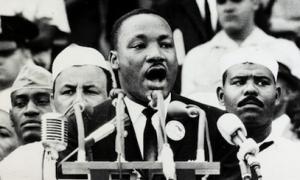
For the past 40 years, February has been formally designated as Black History Month by every sitting U.S. president. While countless Americans of every color sacrificed greatly for equality, Dr. Martin Luther King, Jr. is arguably the most iconic figure of the civil rights movement.
His prominence was due, in part, to exceptional oratory skills and an innate ability to get to the essence of a message – a core message – and communicate it in a way that moved hundreds of thousands to action back then and today. He knew the power of engaging audiences with a clear and compelling message. If you’re aiming to deliver an inspiring presentation that sparks action, read on for tips from one of the greatest.
On August 28, 1963, a record-breaking 250,000 people descended on the Lincoln Memorial in Washington, DC – and they weren’t there to see MLK’s PowerPoint slide deck. Rather, they were drawn to Dr. Martin Luther King, Jr. and his central message of equality. By the end of his talk, they shared his dream. The following strategies, accompanied by excerpts from “I Have a Dream,” can help any presenter identify and communicate a compelling message:
- Have a message. What is the single core message you want to convey to your audience?
For Dr. King it was equality.
- Provide context. What will provide context for your core message?
Five score years ago, a great American, in whose symbolic shadow we stand today, signed the Emancipation Proclamation…
- Create relevance. Does your message matter to audience members?
But one hundred years later, the Negro still is not free. One hundred years later, the life of the Negro is still sadly crippled by the manacles of segregation and the chains of discrimination.
- Make it vivid. Can your audience visualize your message?
But we refuse to believe that the bank of justice is bankrupt. We refuse to believe that there are insufficient funds in the great vaults of opportunity of this nation. And so, we’ve come to cash this check, a check that will give us upon demand the riches of freedom and the security of justice
- Provide vision and confidence. Does your audience see, and believe in, what can be?
I say to you today, my friends, so even though we face the difficulties of today and tomorrow, I still have a dream. It is a dream deeply rooted in the American dream…I have a dream that one day this nation will rise up and live out the true meaning of its creed: “We hold these truths to be self-evident: that all men are created equal.”
- Aim for the head and the heart. Are you engaging their hearts and their minds?
And when this happens, when we allow freedom to ring, when we let it ring from every village and every hamlet, from every state and every city, we will be able to speed up that day when all of God’s children, black men and white men, Jews and Gentiles, Protestants and Catholics, will be able to join hands and sing in the words of the old Negro spiritual, “Free at last! free at last! thank God Almighty, we are free at last!”
Martin Luther King, Jr. was among the greatest orators our nation, and our world, have ever seen. Most of us will never reach that level of skill. However, we can learn a great deal from his example – starting with how to identify and communicate a compelling core message.




